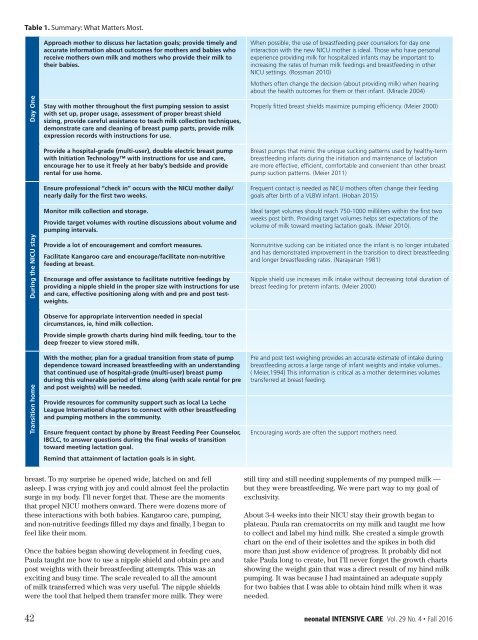INTENSIVE CARE
8dI2AMDUa
8dI2AMDUa
Create successful ePaper yourself
Turn your PDF publications into a flip-book with our unique Google optimized e-Paper software.
Table 1. Summary: What Matters Most.<br />
Day One<br />
Approach mother to discuss her lactation goals; provide timely and<br />
accurate information about outcomes for mothers and babies who<br />
receive mothers own milk and mothers who provide their milk to<br />
their babies.<br />
Stay with mother throughout the first pumping session to assist<br />
with set up, proper usage, assessment of proper breast shield<br />
sizing, provide careful assistance to teach milk collection techniques,<br />
demonstrate care and cleaning of breast pump parts, provide milk<br />
expression records with instructions for use.<br />
When possible, the use of breastfeeding peer counselors for day one<br />
interaction with the new NICU mother is ideal. Those who have personal<br />
experience providing milk for hospitalized infants may be important to<br />
increasing the rates of human milk feedings and breastfeeding in other<br />
NICU settings. (Rossman 2010)<br />
Mothers often change the decision (about providing milk) when hearing<br />
about the health outcomes for them or their infant. (Miracle 2004)<br />
Properly fitted breast shields maximize pumping efficiency. (Meier 2000)<br />
Provide a hospital-grade (multi-user), double electric breast pump<br />
with Initiation Technology with instructions for use and care,<br />
encourage her to use it freely at her baby’s bedside and provide<br />
rental for use home.<br />
Ensure professional “check in” occurs with the NICU mother daily/<br />
nearly daily for the first two weeks.<br />
Breast pumps that mimic the unique sucking patterns used by healthy-term<br />
breastfeeding infants during the initiation and maintenance of lactation<br />
are more effective, efficient, comfortable and convenient than other breast<br />
pump suction patterns. (Meier 2011)<br />
Frequent contact is needed as NICU mothers often change their feeding<br />
goals after birth of a VLBW infant. (Hoban 2015)<br />
During the NICU stay<br />
Monitor milk collection and storage.<br />
Provide target volumes with routine discussions about volume and<br />
pumping intervals.<br />
Provide a lot of encouragement and comfort measures.<br />
Facilitate Kangaroo care and encourage/facilitate non-nutritive<br />
feeding at breast.<br />
Encourage and offer assistance to facilitate nutritive feedings by<br />
providing a nipple shield in the proper size with instructions for use<br />
and care, effective positioning along with and pre and post testweights.<br />
Ideal target volumes should reach 750-1000 milliliters within the first two<br />
weeks post birth. Providing target volumes helps set expectations of the<br />
volume of milk toward meeting lactation goals. (Meier 2010).<br />
Nonnutritive sucking can be initiated once the infant is no longer intubated<br />
and has demonstrated improvement in the transition to direct breastfeeding<br />
and longer breastfeeding rates. (Narayanan 1981)<br />
Nipple shield use increases milk intake without decreasing total duration of<br />
breast feeding for preterm infants. (Meier 2000)<br />
Observe for appropriate intervention needed in special<br />
circumstances, ie, hind milk collection.<br />
Provide simple growth charts during hind milk feeding, tour to the<br />
deep freezer to view stored milk.<br />
Transition home<br />
With the mother, plan for a gradual transition from state of pump<br />
dependence toward increased breastfeeding with an understanding<br />
that continued use of hospital-grade (multi-user) breast pump<br />
during this vulnerable period of time along (with scale rental for pre<br />
and post weights) will be needed.<br />
Provide resources for community support such as local La Leche<br />
League International chapters to connect with other breastfeeding<br />
and pumping mothers in the community.<br />
Ensure frequent contact by phone by Breast Feeding Peer Counselor,<br />
IBCLC, to answer questions during the final weeks of transition<br />
toward meeting lactation goal.<br />
Remind that attainment of lactation goals is in sight.<br />
Pre and post test weighing provides an accurate estimate of intake during<br />
breastfeeding across a large range of infant weights and intake volumes..<br />
( Meier,1994} This information is critical as a mother determines volumes<br />
transferred at breast feeding.<br />
Encouraging words are often the support mothers need.<br />
breast. To my surprise he opened wide, latched on and fell<br />
asleep. I was crying with joy and could almost feel the prolactin<br />
surge in my body. I’ll never forget that. These are the moments<br />
that propel NICU mothers onward. There were dozens more of<br />
these interactions with both babies. Kangaroo care, pumping,<br />
and non-nutritive feedings filled my days and finally, I began to<br />
feel like their mom.<br />
Once the babies began showing development in feeding cues,<br />
Paula taught me how to use a nipple shield and obtain pre and<br />
post weights with their breastfeeding attempts. This was an<br />
exciting and busy time. The scale revealed to all the amount<br />
of milk transferred which was very useful. The nipple shields<br />
were the tool that helped them transfer more milk. They were<br />
still tiny and still needing supplements of my pumped milk —<br />
but they were breastfeeding. We were part way to my goal of<br />
exclusivity.<br />
About 3-4 weeks into their NICU stay their growth began to<br />
plateau. Paula ran crematocrits on my milk and taught me how<br />
to collect and label my hind milk. She created a simple growth<br />
chart on the end of their isolettes and the spikes in both did<br />
more than just show evidence of progress. It probably did not<br />
take Paula long to create, but I’ll never forget the growth charts<br />
showing the weight gain that was a direct result of my hind milk<br />
pumping. It was because I had maintained an adequate supply<br />
for two babies that I was able to obtain hind milk when it was<br />
needed.<br />
42 neonatal <strong>INTENSIVE</strong> <strong>CARE</strong> Vol. 29 No. 4 • Fall 2016


